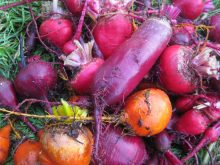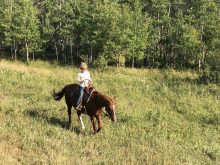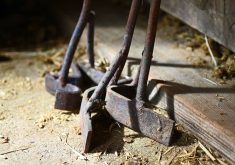Let me first repeat the introduction to these columns. Grainews was first published by United Grain Growers, which was owned by farmers. The first editor, John Clark, recruited several farmers/ranchers to write regular columns that told it as it was “down on the farm.” Farmers writing for farmers was the idea.
Boyd Anderson was a well known rancher from the hills near Fir Mountain, Sask., which is about 170 km southwest of Moose Jaw and just north of the Montana border. In addition to his Grainews columns he wrote books, including Grass Roots, which tells his life story. The “Dirty ’30s” were an especially bad time in the ranching country of what’s now the RM of Waverley No. 44. Farming was tough, as was cattle ranching, so his dad started a sheep herd. Sheep could make it through the winter by scratching through the snow to find the Russian thistle underneath.
At the ripe old age of 14, Boyd spent from November 1934 to late February 1935 herding sheep several miles from home. He stayed in an abandoned two-room farmhouse with a kitchen range for heat and cooking, but with leaky windows that let in snow. There was a well for water but when it froze up he had to melt snow on the kitchen stove. He had a radio with earphones but used it sparingly to save the battery. He only got home on Christmas and Valentine’s Day. He grew up fast that winter.

I think every Grade 8 class in Saskatchewan schools should have Boyd Anderson’s book Grass Roots as required reading. The ‘helicopter’ parenting of today robs the child of the chance to “grow up”. I’ve recently learned that in Saskatchewan our schools are not allowed to fail any student in any grade so they advance through the grades regardless of performance. What is that teaching the kids, and what will happen when they strike out in the real world?
Farming in the RM of Waverley No. 44
While ranching was a challenge in the hills north of the Montana border, farming was even more difficult.
From 1938 to 2022, 30 bushels per acre of wheat was the best she wrote in that southern RM. Boyd Anderson reported that 1937 was a complete disaster. They planted some oats twice but nothing came up; it was the first year he could remember that they never hooked horses to some harvesting machinery.


During the Second World War, Boyd joined up to serve our country. He had to parachute from a floundering plane and was captured, ending up as a prisoner of war and spending some time in a POW camp — an inhumane experience, but he survived to come back to the Fir Mountain ranch and live a long and productive life.
Boyd was very involved in community and farm and ranch groups. He was councillor and reeve of the RM of Waverley for many years. His son is now reeve of that RM, so the tradition carries on. Boyd received many awards over the years, including induction to the Saskatchewan Agricultural Hall of Fame in 1987.

It was my thrill to meet Boyd on two occasions. One was very briefly at Willbar Farms near Dundurn, where Boyd pulled in with his big Cadillac. There was a bus tour on that occasion and I was recruited to give soils/agronomy commentary on the tour.
The second was a more leisurely visit at his home in the town of Glentworth, not far from Fir Mountain. I very much enjoyed the stories he had to tell and learned a bit about how he overcame many adversities to make a large prosperous ranch.
















